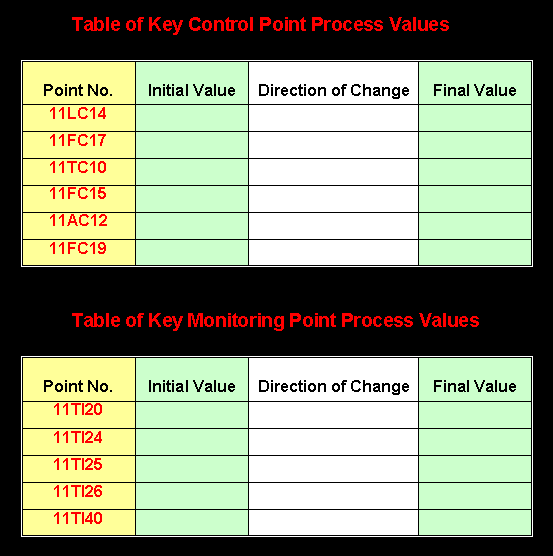

Part 1 of DYNAMIC SIMULATION EXPERIMENT: STEADY-STATE MONITORING
OBJECTIVE
The objectives of this experiment are to enable students to:
(a)
monitor plant performance in steady-state condition and make process adjustments
in a safe and stable manner
(b) understand the dynamic nature of the plant,
through observing the effects of changes in process variables on the column performance
as a whole
INTRODUCTION
The above objectives are to be achieved by making process changes to the following 4 control loops and observe the results:

Please refer to the process flow diagrams (in the Plant
Handbook) for the two distillation plants. The importance of each control
loop is briefly described below.
Loop
1: 11PC16 - Debutanizer Reflux Drum Pressure Controller
This loop controls the debutanizer column pressure. Changes in the
column pressure will result in changes in column temperature, and hence the condensation
of overhead vapour. This in turn, affects the product composition.
Loop 2: 11FC01 - Debutanizer
Heavy Feed
This loop controls the debutanizer heavy feed flow
rate. This affects the amount of heavy feed that enters the column. This changes
the overall feed composition of the debutanizer.
Loop 3: 11TC10 - Debutanizer
Tray 2, Reboiler
This loop controls the steam flow to E-100 reboiler
using 11TC10 Tray 2 temperature controller. Changes in the steam flow rate will
change the extent of vapourization in the hydrocarbon mixture in the bottom of
the column. The temperature of the debutanizer bottoms and vapour-liquid compositions
will be affected.
Loop
4: 11AC12 - Debutanizer Composition Control
This loop controls the amount of heavy components in the column overhead
by adjusting the reflux flow.
PROCEDURE - NORMAL OPERATION
Ensure that the plant is operating at steady-state before carrying out each Exercise. Request the Lecturer-in-Charge to "reset" the simulation if necessary.
There are 4 Exercises, each requiring a change to be made to each of the 4 loops. Complete the datasheets for the 4 Exercises and discuss your results and observations with the Lecturer-in-Charge. Offer explanations on your observations and justify your answers.
Exercise No.1: Changes to Loop 11PC16 (25 marks)
Record
down the Initial Values of in the key control and monitoring process values in
the Table below.
Increase the set point of 11PC16 to 1205 kPag and observe
the changes. Note down the direction of change (Increase, Decrease, No Change)
and the Final Values of the key control and monitoring points.

Explain how changes in the set point of 11PC16 lead to the observed changes in the key control and monitoring points.
Exercise No.2: Changes to Loop 11FC01 (25 marks)
Record
down the Initial Values of in the key control and monitoring process values in
the Table below.
Increase the set point of 11FC01 to 470 m3/hr
(71 MBPSD) and observe the changes. Note down the direction of change (Increase,
Decrease, No Change) and the Final Values of the key control and monitoring points.

Explain how changes in the set point of 11FC01 lead to the observed changes in the key control and monitoring points.
Exercise No.3: Changes
to Loop 11TC10 (25
marks)
Record down the Initial
Values of in the key control and monitoring process values in the Table below.
Increase the set point of 11TC10 to 168 oC
and observe the changes. Note down the direction of change (Increase, Decrease,
No Change) and the Final Values of the key control and monitoring points.

Explain
how changes in the set point of 11TC10 lead to the observed changes in the key
control and monitoring points.
Exercise No.4: Changes to Loop 11AC12 (25 marks)
Record down the Initial
Values of in the key control and monitoring process values in the Table below.
Increase the set point of 11AC12 to 1.5% and observe the changes. Note down
the direction of change (Increase, Decrease, No Change) and the Final Values of
the key control and monitoring points.

Explain how changes in the set point of 11AC12 lead to
the observed changes in the key control and monitoring points.